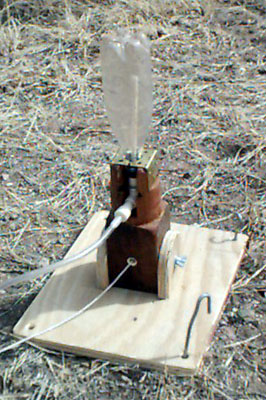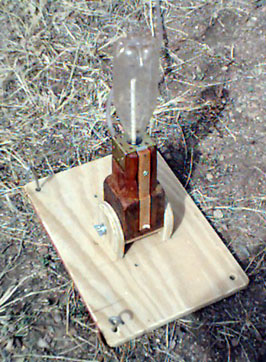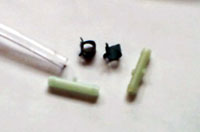Front view >
I was inspired to build a new launcher after I saw a nice design at the 2001 NM state science olympiad in Socorro, NM. This launcher, built by Steve Welch, had been in use for years, and its construction was extremely simple and robust. It was made out of plywood and bits of 2x4. Two hinges with an opening filed out held down the bottle, and the hinges were in turn held closed by a doorlatch. Pull a string that is tied to the latch handle and off it goes.I told my friend Gordon McDonough (of the Interplanetary Water Rocket Society fame) about this, and he remarked that he had rockets where the fins extend below the bottle neck. I therefore made my version not flat, but upright and such that the top part has the same diameter as a 1-liter bottle.
I started with a piece of cedar 4x4 fencepost, and turned down the top to this diameter. Next were the hinges - I had a pair of brass ones that fit the job. Then I carved out space for the rubber stopper, and 1/2" CPVC elbows and stuff.
The trigger string comes out from a hole through the block; It is on the same side as the plumbing.

Back view >
The brass hinges are held down by a strap hinge whose end is bent over to form a hook. In the picture you can just see the bent-over piece, and a strip of oak screwed to the upper half of the hinge. The oak strip forms a lever using the strap hinge pin as a fulcrum. A string comes through a hole at the other end of the oak strip, and goes through a hole in the cedar block. Pull the string, the strap-hinge hook releases the brass hinges and voila. The whole strap hinge and oak piece fit in a recess carved in the cedar block to stay inside the liter-bottle diameter.The cedar block is mounted between two plywood bits with a big carriage bolt with a wing nut. This allows you to pitch the launcher, and to fold it flat for storage. Note that base plywood has holes at the corners for tentpegs.



